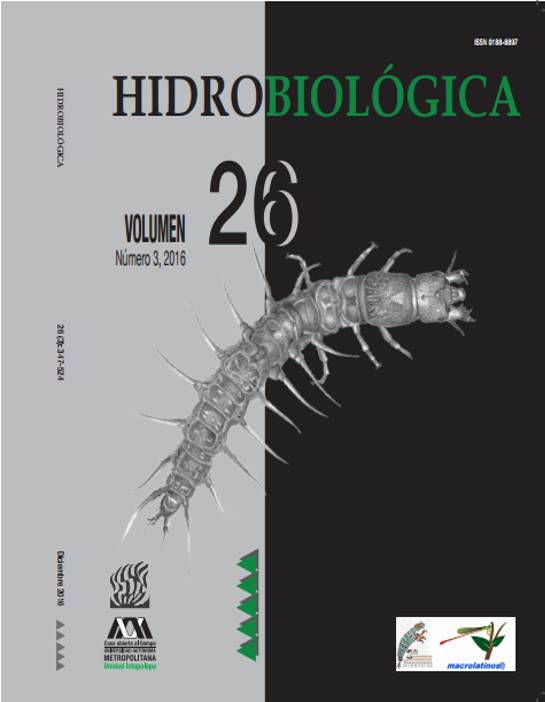Allochthonous vs. autochthonous energy resources for aquatic insects in cloud forest streams, Veracruz, Mexico
DOI:
https://doi.org/10.24275/uam/izt/dcbs/hidro/2016v26n3/GarciaPalavras-chave:
Allochthonous and autochthonous material, cloud forest, food-webs, guts contents, Neotropical streams, trophic basisResumo
Background. Recent tropical studies question the assumption that forested headwater streams rely on allochthonous resources as their main energy source, suggesting that autochthonous resources are more important. Goals. Here, we characterized the energy base, as gut contents, of cloud forest streams with contrasting riparian vegetation cover in Veracruz, Mexico, during dry, rainy and nortes (e.g., less dry and cold) seasons. Methods. Two first-order streams were selected for the study - one flowing through forest and the other through pasture with sparse riparian vegetation. Gut content analyses showed aquatic insect diets composed of diatoms, green algae, fungi, plant tissue, and amorphous detritus. Results. The forest stream had taxa with gut contents composed of 31 to 99% allochthonous material, while the pasture stream reached a maximum of 82% during nortes. Diatoms accounted for most of the autochthonous material in guts, especially in the pasture stream during the dry season. A significant proportion of ingested allochthonous material was fungi, mainly in the forest stream during the rainy season. Conclusions. Overall, our study supports the view that in forested tropical streams autochthonous material is an important food resource. However, allochthonous material was found to be an important food item, even in pasture streams with limited riparian cover.Downloads
Downloads
Como Citar
Edição
Seção
Licença
Los autores/as que publiquen en esta revista aceptan las siguientes condiciones:
De acuerdo con la legislación de derechos de autor, HIDROBIOLÓGICA reconoce y respeta el derecho moral de los autores, así como la titularidad del derecho patrimonial, el cual será cedido a la revista para su difusión en acceso abierto.
Publicar en la revista HIDROBIOLÓGICA tiene un costo de recuperación de $500 pesos mexicanos por página en blanco y negro (aproximadamente 29 dólares americanos) y $1000 pesos por página a color (aproximadamente 58 dólares americanos).
Todos los textos publicados por HIDROBIOLÓGICA sin excepción se distribuyen amparados bajo la licencia Creative Commons 4.0Atribución-No Comercial (CC BY-NC 4.0 Internacional), que permite a terceros utilizar lo publicado siempre que mencionen la autoría del trabajo y a la primera publicación en esta revista.
Los autores/as pueden realizar otros acuerdos contractuales independientes y adicionales para la distribución no exclusiva de la versión del artículo publicado en HIDROBIOLÓGICA (por ejemplo incluirlo en un repositorio institucional o publicarlo en un libro) siempre que indiquen claramente que el trabajo se publicó por primera vez en HIDROBIOLÓGICA.
Para todo lo anterior, el o los autor(es) deben remitir el formato de Carta-Cesión de la Propiedad de los Derechos de la primera publicación debidamente requisitado y firmado por el autor(es). Este formato se puede enviar por correo electrónico en archivo pdf al correo: enlacerebvistahidrobiológica@gmail.com; rehb@xanum.uam.mx (Carta-Cesión de Propiedad de Derechos de Autor).
Esta obra está bajo una licencia de Creative Commons Reconocimiento-No Comercial 4.0 Internacional.


